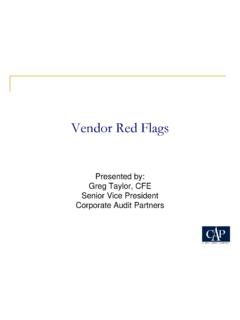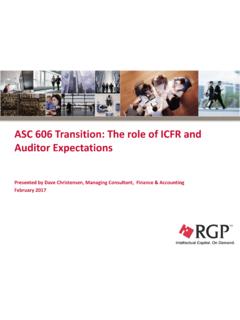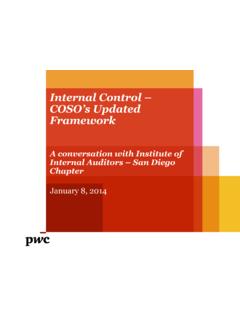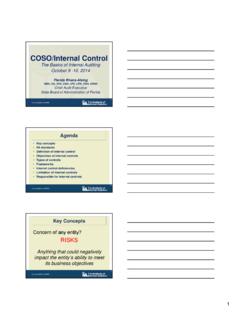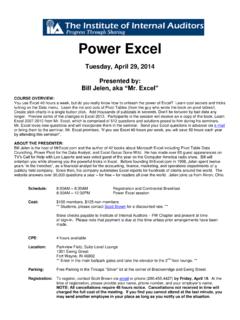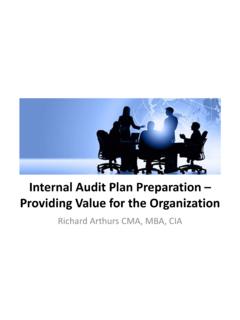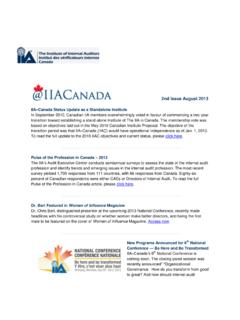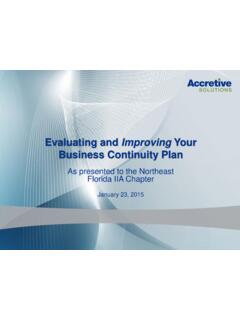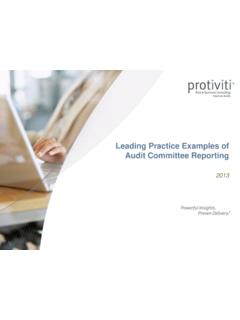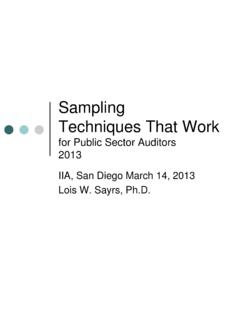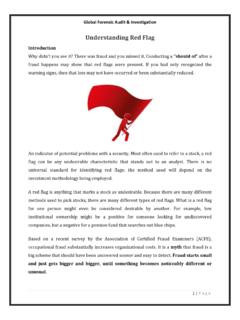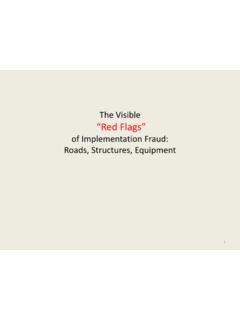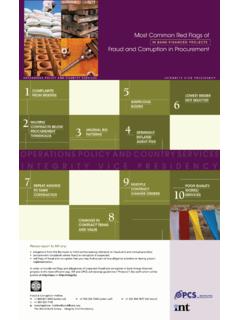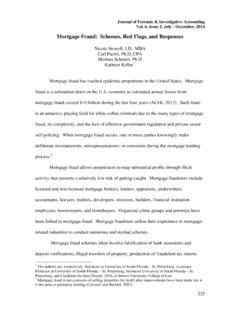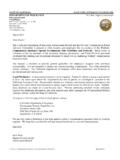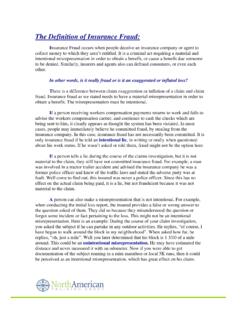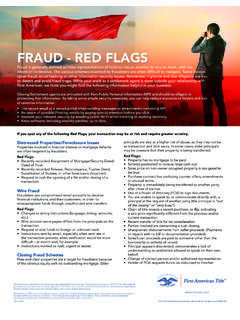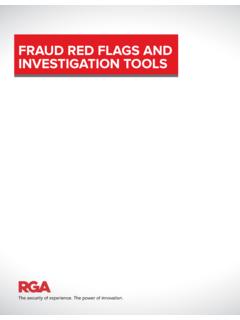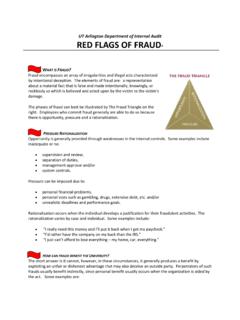Transcription of RED FLAGS OF FRAUD MAY 13, 2014 IIA AUSTIN CHAPTER
1 RED FLAGS OF FRAUD MAY 13, 2014 IIA AUSTIN CHAPTER 2014 by the Association of Certified FRAUD Examiners, Inc. Revised: 3/26/14 No portion of this work may be reproduced or transmitted in any form or by any means electronic or mechanical, including photocopying, recording, or by any information storage and retrieval system without the written permission of the Association. WORLD HEADQUARTERS, THE GREGOR BUILDING 716 WEST AVENUE AUSTIN , TX 78701-2727 USA TEL: (800) 245-3321 +1 (512) 478-9000 FAX: +1 (512) 478-9297 DISCLAIMER Every effort has been made to ensure that the contents of this publication are accurate and free from error. However, it is possible that errors exist, both typographical and in content. Therefore, the information provided herein should be used only as a guide and not as the only source of reference.
2 The author, advisors, and publishers shall have neither liability nor responsibility to any person or entity with respect to any loss, damage, or injury caused or alleged to be caused directly or indirectly by any information contained in or omitted from this publication. Printed in the United States of America. JAMES D. RATLEY, CFE President and CEO Association of Certified FRAUD Examiners AUSTIN , TX James D. Ratley graduated from the University of Texas at Dallas, with a Bachelor's Degree in Business Administration. In 1971, he joined the Dallas Police Department as a police officer. Mr. Ratley was assigned to several police department divisions, including vice, child abuse, and internal affairs. He was a member of numerous department task forces which concentrated on major FRAUD cases. In 1986, Mr.
3 Ratley left the police department to join Wells & Associates, a forensic accounting practice, where he was in charge of FRAUD investigations. He handled investigations regarding internal frauds, conflicts of interest, and litigation support. In 1988, he was named Program Director for the Association of Certified FRAUD Examiners and oversaw all aspects of the ACFE's training and education programs. In 2005, Mr. Ratley was awarded the Association of Certified FRAUD Examiners' Cressey Award. The Cressey Award is the ACFE's highest honor. It is bestowed annually for a lifetime of achievement in the detection and deterrence of FRAUD . In 2006, Mr. Ratley was named President of the ACFE. In this role, he works to promote the ACFE to the public and other professional organizations and continues to assist in the development of anti- FRAUD products and services to meet the needs of the ACFE's members.
4 In addition to his executive duties, Mr. Ratley serves as a member of the ACFE's faculty, and teaches regularly at workshops and conferences on a variety of FRAUD -related subjects. Mr. Ratley was named One of the Top 100 Most Influential People in Accounting by Accounting Today in 2012, with the magazine praising his leadership in a "changing, growing and evolving" accounting landscape. He was also selected as one of Security magazine's Most Influential Security Executives for 2010. This honor is bestowed each year to the top security executives who positively impact the security industry, their organizations, their colleagues and their peers. Mr. Ratley is a member of the Association of Certified FRAUD Examiners, AUSTIN CHAPTER , and a member of the Board of Advisors for the Institute for Bank Director Education.
5 He was also a Visiting Scholar at the University of Nebraska in Lincoln. In addition, he has been certified as a Master Peace Officer by the Texas Commission on Law Enforcement Standards and Education. RED FLAGS OF FRAUD 2014 Association of Certified FRAUD Examiners Page 5 NOTES The Detection of FRAUD FRAUD is generally detected by one of four means: Tips or complaints Internal controls The perpetrator turning himself/herself in Assessment of red FLAGS Tips or Complaints Tips or complaints have been known to be some of the best means of FRAUD detection and should be taken seriously. In fact, research consistently shows that tips from employees, customers, vendors, and other sources are the method by which the most frauds are detected. Although occasionally the motives of the complainant may be suspect, the allegations usually have merit and warrant further investigation.
6 Internal Controls Certain internal controls, such as management review, surveillance and monitoring activities, account reconciliations, and document examinations, are designed to detect errors and FRAUD . Likewise, internal and external audits serve as important controls in uncovering potential fraudulent acts. Perpetrator Turning Himself/Herself In Committing a FRAUD and keeping the crime hidden takes a continuing effort on the part of the fraudster. Because of the increased likelihood of detection, fraudsters aren t able to take vacations or sick time. Although it may not be a common occurrence, some fraudsters find that they cannot deal with the emotional expense of the FRAUD and may eventually turn themselves in, choosing to face the consequences of FRAUD over continuing the effort of concealment.
7 RED FLAGS OF FRAUD 2014 Association of Certified FRAUD Examiners Page 6 NOTES Assessment of Red FLAGS A red flag is a circumstance, or set of circumstances, that is unusual in nature or varies from the normal activity. It is a signal that something is out of the ordinary and should be further investigated. If you analyze a FRAUD case, you will usually uncover the presence of red FLAGS , which, had employees or auditors noticed or reported, might have resulted in the FRAUD being detected earlier. Frauds committed by employees and management frequently involve obvious signs of FRAUD if those around the perpetrator know what to look for. General Red FLAGS Typically, the FRAUD will result in symptoms that can signal other employees or auditors to the crime. Warning signs relating to potential FRAUD can be broken down into several categories.
8 These categories are: Accounting anomalies Internal control weaknesses Analytical anomalies Operational anomalies Behavioral anomalies Accounting Anomalies Accounting anomalies are unusual deviations from the standard accounting practice. They involve irregularities in the accounting system, such as: Missing, altered, or photocopied documents Stale items on reconciliations Increased or excessive past due accounts Unexplained or confusing journal entries Inaccuracies in the ledger accounts Unexplained changes in financial statements RED FLAGS OF FRAUD 2014 Association of Certified FRAUD Examiners Page 7 NOTES Internal Control Weaknesses Common internal control weaknesses that can serve as red FLAGS of FRAUD are: Lack of segregation of duties Lack of physical safeguards Lack of independent checks Lack of proper authorization on documents and records Overrides of existing controls Inadequate accounting system Analytical Anomalies Analytical anomalies are relationships, procedures, and events that don t make sense either common or business or that appear to be unreasonable.
9 These include transactions that happen at odd times or places, transactions that involve people who would not normally be a part of the event, transactions that involve amounts that are too small or too big, and transactions that occur too often or too rarely. Examples of analytical anomalies include: Company assets sold under market value Excessive number of checking accounts Frequent changes in banking accounts Use of several different banks Significant downsizing in a healthy market Unexpected overdrafts or declines in cash balance Operational Anomalies Operational anomalies are unusual events concerning the company s operations. Such circumstances may or may not be within the control of management, but they do merit consideration as a red flag for possible FRAUD . Some of these anomalies are.
10 RED FLAGS OF FRAUD 2014 Association of Certified FRAUD Examiners Page 8 NOTES Operating on a crisis basis Insufficient capital Dependence on only one or two products Frequent changes in legal counsel Frequent changes in executive management and directors High employee turnover, especially in areas that are more vulnerable to FRAUD Continuous rollover of loans A compensation program that is out of proportion to profits Unusual organizational structure ( , having the internal audit department report to the finance department) Severe obsolescence of assets Problems with government regulators Behavioral Anomalies The vast majority of fraudsters display some sort of behavioral symptoms of their scheme symptoms that co-workers or supervisors might have picked up on without realizing that they were connected to fraudulent actions.
